
“The toughest opponent of all is the one inside your head”, Joe Henderson professional running coach. One of the most humbling, yet inspiring moments in life can be found when “self overcomes self”. In first becoming triumphant in life’s battles, one must face the negative voice within. When we discover helpful tools that encourage growth and positive outlooks, the giants we face look smaller. Recovery from drug and alcohol addiction is no easy feat. Kickboxing, however, can help aid the process in enormous ways.

“It’s not just self-defense, it’s about self-control, body discipline, and mind discipline and breathing techniques. It involves yoga. It involves meditation. It’s an art, not a sport.” -Elvis Presley
In practice, Kickboxing requires patience, endurance, and self-awareness. The results that kickboxing produces physically and mentally are truly amazing. Kickboxing can be a fundamental tool in addiction recovery.
Historically speaking, kickboxing has been around for thousands of years. Originating in eastern Asia, it has since spread and is now practiced all across the world. It has been modified and changed over the years diverging from the formal Muay Thai Boxing. What does kickboxing involve exactly? Kickboxing can be defined as “a traditional Thai martial art in which the fists, elbows, knees, and bare feet may all be used to deliver blows.” Today, kickboxing is not solely a contact sport which adds a neat dimension to the practice.
Kickboxing is a learning experience. However, it is not your typical learning experience. Here at Bridging the Gaps we have implemented Kickboxing into our programming and have seen amazing results. Individuals may come broken, tired, shamed, and searching. At first, engaging in kickboxing might be met with some internal challenges. One might feel uncomfortable because they feel unfamiliar with the practice. Others may find they feel uncertain of the capabilities they possess.
Once those walls are kicked down though, you better watch out!
“The best way to pursue any discipline is the martial art way, and that’s why it’s been around for thousands and thousands of years. That whole idea of honor and discipline and respect, that’s not there because just as a frivolous afterthought, that’s there because thousands of years of training people that is really the best way to excel and be… and be great.” -Joe Rogan
“It is an inspiring thing to witness. Seeing clients at the beginning of the process and how they continue to improve each week. Their form improves, their confidence improves, their “respect for self” improves. One of the greatest joys I’ve felt is when I see clients enjoying kickboxing. It warms my heart to see them growing so much throughout the sessions.”

Kickboxing is a grounding experience. While there are many thoughts and to-dos that demand our attention daily, kickboxing calls one to be present. One must be present in the moment, and present in the practice. Healing happens when walls are broken down and confidence is built up.
As one of our integrative modalities, we can attest to healing and health benefits that activities such as Kickboxing bring. Restoration in life can truly begins once healthy avenues are established. Here at Bridging the Gaps, we believe in providing avenues in which clients can explore new ways of life, living, and interests that will continually go to support their recovery process.